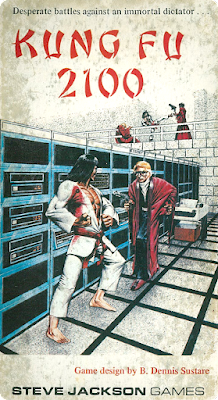Retrospective: Kung Fu 2100
 I'm a huge fan of "micro-games" (also known as "mini-games" and "pocket games," among many other monikers). I was an avid player of TSR's forays into this field, but it was the designs published by Steve Jackson Games that first introduced me to the concept. Broadly speaking, most micro-games existed in a space somewhere between boardgames and wargames and came in small containers, whether ziplock bags, plastic clamshells, or pocket boxes. All micro-games featured relatively simple rules and components, which is why they were generally playable in about an hour or so. This was a big part of the appeal of micro-games to me and my friends. We'd often pull out Revolt on Antares or Ogre when we were waiting for the rest of the gang to assemble for D&D. They were a fun way to pass the time, even if you were just watching others play them (most micro-games were two-player).
I'm a huge fan of "micro-games" (also known as "mini-games" and "pocket games," among many other monikers). I was an avid player of TSR's forays into this field, but it was the designs published by Steve Jackson Games that first introduced me to the concept. Broadly speaking, most micro-games existed in a space somewhere between boardgames and wargames and came in small containers, whether ziplock bags, plastic clamshells, or pocket boxes. All micro-games featured relatively simple rules and components, which is why they were generally playable in about an hour or so. This was a big part of the appeal of micro-games to me and my friends. We'd often pull out Revolt on Antares or Ogre when we were waiting for the rest of the gang to assemble for D&D. They were a fun way to pass the time, even if you were just watching others play them (most micro-games were two-player). Last night, a friend mentioned a micro-game I hadn't thought about in a long time, Kung Fu 2100. Originally appearing in the pages of issue #30 of The Space Gamer (August 1980), the game would eventually be released as a separate product later that same year. That's how I first encountered it, as I rarely saw, let alone read The Space Gamer. Nevertheless, I was a keen player of Steve Jackson's micro-games (especially Car Wars) and snapped them up whenever I came across new ones. In the case of Kung Fu 2100, that happened while on vacation with my family and I chanced upon a little game store that was surprisingly well stocked with games I'd never seen before, including this one.
Kung Fu 2100 is wonderfully strange. Designed by Dennis Sustare, whose contributions to the hobby are many, the game's premise is a delightful goulash of 1970s pop cultural concerns, from cloning to martial arts to the end of human civilization. According to the history presented in its rulebook, human cloning is perfected in 2006, a complicated process that requires not only high technology – take a look at the computer banks and dot matrix printer depicted on the cover! – but the wealth to afford it. The cloning process involves the growth of a physical copy of the biological donor, as well as a copy of the donor's personality, memories, and experiences. Taken together, this opens the door to virtual immortality to those with financial means, setting off riots and unrest, as the masses realize what this means for society. The powerful, who come to be known as CloneMasters, eventually restore order, but only be repressive means, right down to outlawing the possession of most modern technology by anyone but themselves.
If this sounds utterly ridiculous, it is, but, as the premise of a game where one player takes the role of members of a secret society pledged to end the tyranny of the CloneMasters, it's perfect. Members of the Society of Thanatos, as it is known, train from childhood to use only their bodies to fight, since most weaponry is now forbidden to anyone but the CloneMasters and their servants, some of whom are Thanatos turncoats. The masses, who revere these martial artists as heroes, call them Terminators and cheer them on. The game itself focuses on an attack by the Terminator player on a CloneMaster fortress, with the goal of slaying the CloneMaster who dwelled within. The goal of the CloneMaster player, of course, is to prevent this from happening.
Kung Fu 2100 consisted of a fortress map, some counters, a rulebook, and record sheets – fairly standard components for a micro-game. The sequence of play involves multiple phases of movement, combat, and recovery within each turn, with the Terminator and CloneMaster players alternating between them. Combat, specifically hand-to-hand combat, is quite interesting, in that Terminators (and their enemy counterparts, the Janizaries [sic] or "Jellies") having a choice of tactics to choose from, such as Iron Fist, Lightning Foot, Monkey Soul, and Body of Mist. These tactics are compared to one another on a combat results table, with some each having situational advantages and disadvantages. It's a neat little system that's both easy to use and flavorful. Like many micro-games, Kung Fu 2100 also includes rules for solo play, which is useful on days when no one else is available.
Sadly, this wasn't a game I played much back in the day, not for lack of interest. However, with so many other micro-games available to us, we tended to opt for those that we'd played before, leaving Kung Fu 2100 an also-ran at best. I'm not quite sure what happened to my copy of it. After my conversation last night, I find myself wishing I still had it, if only to take a closer look at its components and luxuriate in the warmth of late '70s pop culture cranked up to 11. Even better would be to get the chance to play it again.
James Maliszewski's Blog
- James Maliszewski's profile
- 3 followers



